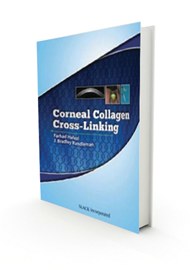As the title suggests, this publication provides a single volume that collates much of the current knowledge and application for corneal collage cross-linking (CXL). There are 23 chapters, subdivided into seven sections, including five pages of indices. The chapters are generally brief, between four and eight pages long. The introduction to corneal biomechanics and the evaluation and diagnosis of keratoconus and pellucid marginal corneal degeneration are more extensive.
Other chapters cover the etiology and diagnosis of corneal ectatic disorders; technical and patient related aspects of CXL; paediatric CXL; applications of CXL stabilisation management for infectious keratitis, corneal melts and corneal stromal oedema; CXL combined with refractive surgery procedures in non ectatic eyes; and recent developments in CXL. Reference lists are provided for each chapter. There is a summary of commercially available CXL units, and a list of the US Food and Drug Administration CXL clinical trials being undertaken at the time of publication. The 42 contributors, more than half based in Europe, list their financial disclosures for the material presented within the text.
Each chapter can be read independently, chosen to reinforce current knowledge or to satisfy one’s curiosity about a particular aspect of the technology. It is highly readable and the colour photographs, topography images, tables and flowcharts enhance the script. Some chapters are more biased either towards the clinical or theoretical features. For those interested in the theory behind the procedure there are details on the biomechanical behaviour of the cornea, the principles behind standardised treatment protocols and optimising its parameters to avoid unwanted complications and explanations for the corneal remodelling responses after CXL.
There is some duplication of the text content and a reference list of abbreviations used throughout the book would be a useful aid, but these are minor criticisms. Undoubtedly, with such a relatively recently introduced treatment, the technique and its applications are rapidly evolving so the cost of a book on the subject, in this case £140, may be difficult to justify when there are some excellent review articles published in peer-reviewed ophthalmic journals. For myself, each source is complimentary and this book should appeal to a wide audience involved in the clinics, from the ophthalmic technician, or the contact lens practitioner, through to the surgeon selecting suitable candidates for the procedure and optimising the process to achieve successful outcomes. It deserves to be recommended reading for the corneal clinic support team.




